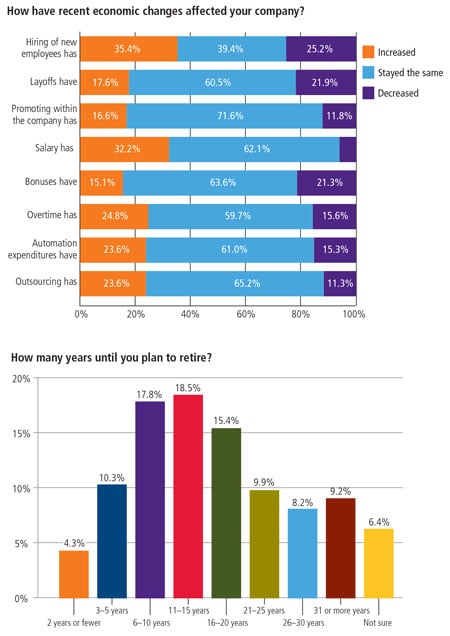This was written by Rick Zabel, vice president, publisher and editor at Automation.com.
Editor's Note: The following salary and career perspectives are based on a 2013 industry survey.
Every year, when I sit down to write this article, I am a bit challenged to come up with some new and interesting data to share with you. This year was no different. At first glance, the salary data does not seem to change much from year to year. Sure, there is always a little fluctuation in the salaries by job function, degree, industry segment, etc.
For example, the average salary in the U.S. has increased by 2.8 percent. Ho hum. The top paying job function is engineering management. Did not see that coming! Actually, I did. So what do we have that is new to share this year?
It turns out that we have extracted some pretty interesting data from this year’s survey. Be sure to read the entire article, because at the end I provide you with a recipe to achieve the highest salary.
There is definitely some good news. Salaries have increased slightly, but job satisfaction has increased more – by five plus percentage points. It is definitely a job seekers market. The demand for quality automation professionals continues to increase. In fact, if you are in the market for a new job, you will likely have multiple offers on the table. The bad news is the skills shortage is very real and will not get better any time soon.
So without further ado, InTech magazine again collaborated with Automation.com to conduct the annual salary survey. Our survey had 4,674 responses from automation professionals located around the world, with 56 percent from the U.S. Because salaries around the world vary greatly, we broke out the U.S. responses only to avoid skewing results. All the results quoted in the article, other than average salary by region of the world, represent U.S. responses only.
Snap shot of typical respondents
The job function of the typical survey respondent was an automation/control engineer, accounting for 28.2% of total responses. The most prominent average age range was 45-54, indicated by 34.1% of respondents. Nearly half (45.6%) of the respondents were college graduates with a bachelor's degree, with the largest percentage of those (36.5%) possessing a bachelor's degree in electrical engineering. Of the respondents, 16.3% have an advanced degree, of which the largest percentage (28.4%) acquired a business administration degree.
The largest percentage of respondents (25.6%) has 31 or more years of professional work experience. It is interesting to note that the largest percentage of respondents (nearly one quarter or 24.8%) has worked for their current employer two years or fewer.
Of the respondents, 78.3% (up 4% over last year) reported a salary increase this year, with the largest percentage (50.6%) seeing a 1%-3% increase. At least a portion of the compensation of 64.7% of our respondents came in the form of commissions or bonuses, with 38.5% of respondents reporting that 1%-10% of their salary is commissions or bonuses. The largest percentage of respondents (35.3%) clocked between 41 and 45 hours per week, and the average vacation time was three weeks per year. Now, the article will dive a little deeper into the results.
Salary facts
The largest percentage of respondents (23.6%) reported a salary in the $100,000-$124,999 pay range. The second largest percentage (13.7%) was in a pay range of $125,000-$149,999. The average salary in the U.S. is now up to $106,772-that is an increase of $2,862 (or 2.8%) from last year. Two other regions of the world reported a higher average salary. Canadian respondents reported an average salary of $118,483, while Australia and New Zealand respondents reported a whopping $131,483. It is interesting to note that the dollar exchange rate in both of these regions is fairly close to a 1:1 ratio. However, the cost of living is typically higher in both regions, and the average salaries reflect those higher living expenses.
Within the U.S., the highest paid region is the west south central (south), with an average salary of $120,750, which is a $4,180 increase over last year. The lowest paid region is the east north central (midwest), with an average salary of $96,041, a $6,871 increase over last year. (Regions are defined on Wikipedia.)
The average salary of the largest percentage of respondents by job function (28.2%, automation/control engineering) was $105,650, which is a $1,610 increase over last year. The top five highest paid job functions are listed below.
- Engineering management: $137,761 (6.6% of respondents), a $5,041 increase
- Safety systems engineering: $129,285 (1.1% of respondents), a $7,255 increase
- Consulting engineering: $127,398 (3.8% of respondents), a $3,108 increase
- Sales (outside): $121,848 (4.5% of respondents), a $4,828 increase
- Project management: $120,543 (3.5% of respondents), a $9,323 increase

A degree of higher learning
Of respondents, 69.2% possessed a college degree or higher. The average salary of college graduates (without an advanced degree) is $109,029. The results show that those who attended at least some graduate school (but did not finish) were able to increase their annual salary by $5,647. Those respondents who actually completed an advanced degree reported an average salary of $123,004-that is a $13,975 increase (virtually unchanged from last year) over college graduates.
The largest percentage of respondents (33.1%) received a bachelor's degree in electrical engineering, pulling in an average salary of $117,416, an increase of $4,666 over last year. The top five average salaries by degree are:
- Chemical engineering: $123,789 (12.5% of respondents)
- Physics: $123,125 (1.2% of respondents)
- Other science: $122,222 (2.1% of respondents)
- Liberal arts: $116,402 (1.9% of respondents)
- Computer science: $112,459 (2.9% of respondents)
Participants in our survey work in 40 different industry segments. The largest number of responses came from the engineering services segment (12.3%), where the average salary is $123,444. It is interesting to note which industries are the biggest payers. The top five highest salaries are paid to professionals in these industry segments:
- Petroleum refining and related industries: $125,805 (5.7% of respondents)
- Oil and gas extraction: $125,326 (4.4% of respondents)
- Instrument and control apparatus sales and service: $115,105 (3.6%)
- Utilities combination (nuclear/fossil fuel, etc.): $114,698 (2.2%)
- Chemicals: $113,020 (6.4%)
Stating the obvious . . .
Again this year, we compared the salary of those with a professional engineering license to those without a license. It is no surprise that those with the license (16.1%) earn an average of $21,118 more each year, or an average salary of $124,857 versus $103,739 for those without the license.
As you would expect, the average salary consistently increases with years of professional work experience. Those professionals with two or fewer years of experience average $61,599 per year, a $3,659 increase over last year. On the other end of the spectrum, those with 31 or more years of experience are being paid an average of $117,492 per year, virtually the same as last year. The great news is that over the course of your automation career, you can expect to almost double your income potential.
The average salary also consistently increases as your tenure with a company increases. The average salary of a professional who has been at his or her company for fewer than 2 years is $94,753. That compares to $114,398 for those who have been at their company for 21 years or longer.
Another expected data point is that the average salary of an employee gradually increases with the number of people reporting to him or her. With no direct reports, the average salary is $102,170. The average salary increases to more than $200,000 when the number of reports exceeds 500 people.
If you look around your office or attend any industry events, you will notice the sheer lack of females in the automation profession. This year the percentage of female respondents crept up slightly from 5.1% last year to 6.3%. Along with that gender gap comes a salary gap of about $11,283. The average salary for a male is $107,487, while the average salary for a female is $96,204.
Getting tired of putting in those long hours? You might want to think again. The average salary of the respondents gradually increased with the number of hours worked each week. Here is how it breaks down:
Are you thinking of becoming an independent contractor? Our survey indicates that contractors make about $10,000 more per year than a direct employee. The average salary of a contractor (5.3% of respondents) is $116,636. That $10K may not be enough to cover the cost of insurance and other benefits available to direct employees, however.
Does company size matter?
For those companies with fewer than 30 employees, the average annual salary is $100,730. As the size of the company increases above 30, but below 50, the average salary takes a dip to $89,301. The next size bracket of companies, 50-99 people, pays an increased average salary of $103,152. For the next size bracket of companies, 100-249 employees, the average salary takes another dip to $94,333. For companies with more than 250 employees, the salary trend line is pretty consistent. If the size of the company exceeds 10,000 employees, the average annual salary caps out at $121,390.
In general, you can earn more money by working for a company with 1,000 or more employees and staying with that company for the duration of your career.
Job satisfaction rises 5+%
The job satisfaction of automation professionals is at an all-time high since we started publishing salary data in 2005. As many as 85.6% of respondents indicated they are satisfied with their jobs, up 5.6% over last year. With a corresponding average salary of $114,014, 40.4% of respondents, up 6.6% over last year, said they are very satisfied. The somewhat satisfied, making up 45.2% of responses, are making $102,660. The very dissatisfied comprise only 1.9% of respondents, making $87,959 per year.
Based on the survey results, this job satisfaction is tied to a number of factors. While salary is a leading factor, it is not the only factor. Like previous years, the feeling of accomplishment rated the highest, with technical challenge, benefits, salary, pleasant work environment, good relationship with work colleagues, and job security also contributing factors. The top four most important benefits are health insurance (63.6%), pension plan/401K (47.7%), flexible working hours (40.5%), and paid time off (33.2%).
Again this year, we asked respondents to tell us if they were currently seeking new job opportunities. Those who are actively seeking new opportunities made up 8.0% of respondents and had an average annual salary of $98,166-about $8,000 less than the average. Passive job seekers made up 36.9% of respondents, whose average salary was slightly less than average at $104,103. Those not seeking new opportunities (55.1%) were making an above average salary of $109,809.
There is a message here for employers. If you are paying less than the industry average, you could very likely lose your engineers. Based on data from automationtechies, a recruiting and contract staffing company based in Minnesota, there is a high demand for automation professionals, and high-quality candidates are hard to find. When companies do find good candidates, the candidates typically have multiple offers on the table. If your company employs high-quality professionals, pay them well, or you may lose them.
When we asked survey respondents if they were happy working in the automation profession, nearly 80% said "yes." Only 2.2% said "no," and 18.0% said "sometimes." Those who said "yes" are making just slightly higher salaries than the average-$107,772. However, those who said "no" are making significantly less than the average-$90,875. Those who are happy "sometimes" came in just under the average at $104,356.
Married with children
This year we decided to ask respondents about their personal lives to see if there might be any correlation between salary and marriage or children.
When analyzing the data of all age groups, the survey showed that married professionals (80.3% of respondents) make an average of $110,534 per year. On the other hand, single professionals (11.3% of respondents) reported a significantly lower average salary of $83,190. Those professionals who are divorced (6.5%) reported a salary of $102,617. Respondents with children (79%) reported an average salary of $110,196, while those without children reported an average salary of $93,879.
After running these numbers, we realized that the married/children factors could be directly tied to age. Younger professionals tend to be single with no kids, but also tend to make lower salaries due to lack of experience. So, we looked at the largest age bracket of respondents (45-54) and ran the same analysis. Those who are married reported an average salary of $114,015 and those who are single reported an average salary of $106,420. Divorced professionals in that age bracket reported $103,012. In this age group, children or no children did not play as big of a role. Those with children reported an average salary of $112,846, while those without children reported $111,378.
When asked if respondents would encourage their children (or the next generation) to seek a profession similar to theirs, a whopping 84.9% said "yes," an increase of 12.3% over last year. This encouragement gives those in the automation profession hope that we can close the skills gap.
Outsourcing and mergers/acquisitions
When asked if their company outsources professional/engineering services, 58.9% of the respondents said "yes," while 35.1% of respondents said "no." Six percent were unsure. An interesting data point is those who said "yes" reported an average salary of $109,740, which was $5,391 higher than those who said "no."
When asked if their company had undergone a merger or acquisition in the past three years, a shocking 29.7% said "yes," while 66.1% said "no" and 4.2% were unsure. Another interesting data point is those who said "yes" reported an average salary of $111,673, which was $6,107 higher than those who said "no."
Industry organization members
Once again this year, the results indicate that professionals who are members of industry organizations pulled in higher salaries, on average, than those who are not members. For example, almost half of all respondents (48.3%) are ISA members, and their average salary is $111,297. Compare that to respondents who do not belong to any organizations (34.1%), whose average salary is $97,704. It pays to join and get involved with well-known industry organizations.
Getting paid for overtime
More than 60% of respondents do not get paid for overtime. However, their average salary is $11,000 more than those who do get paid for overtime. The average salary of those who get paid for overtime is $100,201, while the salary for those who do not get paid for overtime is $111,547.
Of those respondents who do get paid for overtime, 28.4% reported an average salary of $124,307, which includes straight time pay for hours over 40 per week. Of this group, 55.4% gets paid traditional overtime, which is 1.5 or 2 times the hourly rate, but they report a much lower average salary of $88,224.
Talent is hard to get
When we asked respondents if their company has a hard time finding/hiring automation professionals, nearly 60% said "yes." The job function that is hardest to fill, as identified by 61.9% of the respondents, is automation/control engineering. A distant second was instrumentation engineering (28.2%), followed by process engineering (17.1%).
There is nothing new here. We are in the middle of a skills shortage. By many estimates, we failed to train an entire generation of technical professionals. As the bar chart indicates, more than half (51%) of those surveyed said they will be retiring in the next 15 years.
Is there a silver lining? Many companies end up hiring retirees back to work as consultants, simply because they cannot find other employees with the necessary skills. It appears that the number of retirees who are willing to work after retirement is holding at 45.8% (exactly the same as last year). These respondents said they will retire in the next 10 years, but indicated they will continue to work part-time or offer consulting services after retirement.

Economic effects
We asked our survey respondents to give us an idea of how the economy is affecting certain factors within their companies.
For the majority of respondents (more than 60%), most of the factors like salary, bonuses, overtime, layoffs, and promotions remain unchanged. However, here are three positive signs within some companies:
- 35.4% indicated that hiring of new employees has increased.
- 32.2% indicate that salaries have increased.
- 24.8% indicate that overtime has increased.
Conclusion
If you made it to this part of the article, congratulations! As a reward, I would like to present you with the following recipe of how to achieve the highest salary:*
- Get your B.S. degree (any type of engineering will do). An advanced degree will improve results.
- Select an energy-related industry segment.
- Select a large company, preferably one with 10,000 or more employees, and stay there for your entire career.
- Get your professional engineering (P.E.) license.
- Move into a management position where employees report to you.
- Work more than 50 hours per week.
- Blend in one spouse.
- Add one or two children (optional).
- Become a member of a prominent industry organization.
- Allow ingredients to intermingle during your career.
*Editor's note: results may vary depending on elevation.
About the Author Rick Zabel is vice president and publisher of Automation.com. A special thank you goes out to all of you who took the time to complete our survey and to Jessica Kooiman and Kia Weller at Automation.com for all their help in creating the survey and compiling the data.
Rick Zabel is vice president and publisher of Automation.com. A special thank you goes out to all of you who took the time to complete our survey and to Jessica Kooiman and Kia Weller at Automation.com for all their help in creating the survey and compiling the data.
A version of this article originally was published at InTech magazine.




